Economics HL Unit 2
Marginal rate and substitution
MRSxy = oppurtunity cost, slope of indifference curve
A series of optimal consumer choices provides the theoretical basis for an individual demand curve
Diminishing marginal utility
as we consume more of a good, the satisfaction we derive from 1 additional unit decreases
rate of satisfaction diminishes with every 1 unit
examples: food, cars
Indifference curves
IC always has a negative slope if consumer likes both goods
IC cannot intersect
Every good can lie on one IC
ICs are not thick
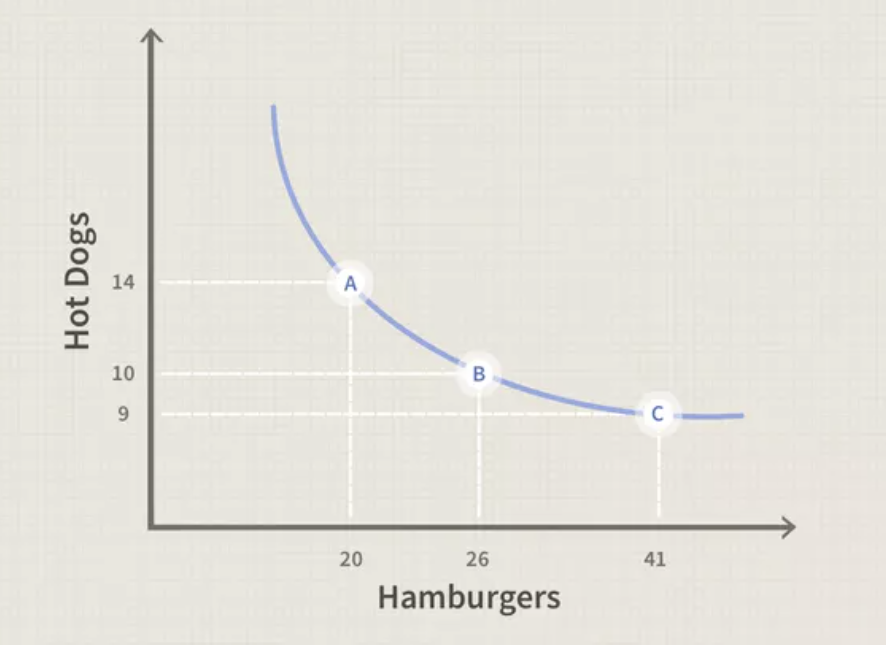
Demand Theory
Substitute effect
Measures of consumer MRSxy, before and after the price change
Amount of additional food the consumer would buy to achieve the same level of utility (assuming a price decrease in one good)
Moving from one optimal curve to another
Steps:
Identify initial optimum basket of goods
Identify final optimum basket of goods, after the price change
Identify the decomposition optimum basket (DOB), attributed to the substitution effect
DOB must be on a BL that is parallel to BL2 following the price change
Assume that consumer retains same level of utility after the price change
Income effect
Accounts for price change by holding the consumer’s purchasing power (following price change) constant and finding an optimum bundle on a new (higher/lower) utility function
Purchasing power - number of goods/services that can be purchased with a unit of currency (falls when price increases)
Measured from the DOB (B and Xb) to the final optimum bundle, following price change (C and Xc)
Both effects move in the same direction
Law of Demand
At a higher price, consumers will demand a lower quantity of a good (vice versa)
Relates to diminishing marginal utility by compensating (off-set) DMU must be negatively related to quantity
Inverse relationship of price and quantity
Given the presence of diminishing marginal utility, in order to promote increased consumption, prices must fall
For a “normal good,” the increase in consumption results from a fall in price - this is driven by:
a lower MRSxy, while remaining on the same IC generates increased consumption of good X (substitute effect)
the theoretical increase in income necessary to lift the consumer to the higher IC, while keeping the ratio of prices at the new level (income effect)
Economic theory of demand always starts at the individual level. A horizontal summation of many individual demand curves provides a market demand curve. Market demand curves are always less steep than individual demand curves
Determinants of Demand
Income
Price of substitutes/complements
Number of consumers
Preference or tastes
These factors cause a market demand curve to shift (change in demand)
Individual Demand Curve
a series of optimal choice bundles across different price levels (shown on price-quantity graphs)
Inferior Good
whether the substitution effect or income effect dominates in an empirical not theoretical question
Opposite of a normal good, demand falls when income rises
Non-price determinants of demand
income (normal good)
income (inferior good)
preferences/tastes
price of substitute/complement goods
number of consumers
Perfect Competition
Economic profit maximization is the assumed goal of private firms
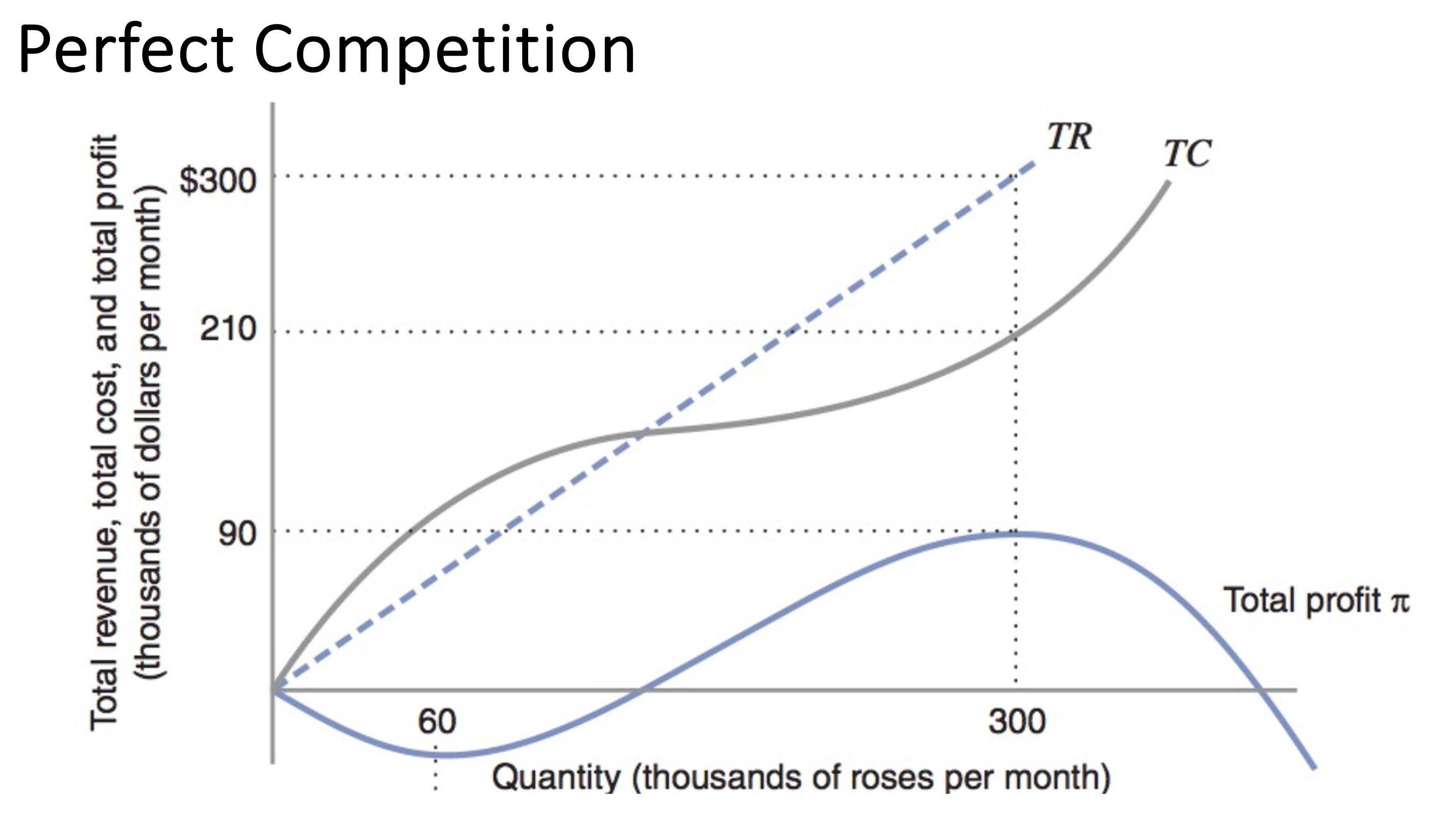
Total cost represents the most efficient combination of inputs for a given level of output
The rate at which total revenue (TR) changes with respect to change in output (Q) is marginal revenue (MR)
MR = TR/Q = (Q*P)/Q = P
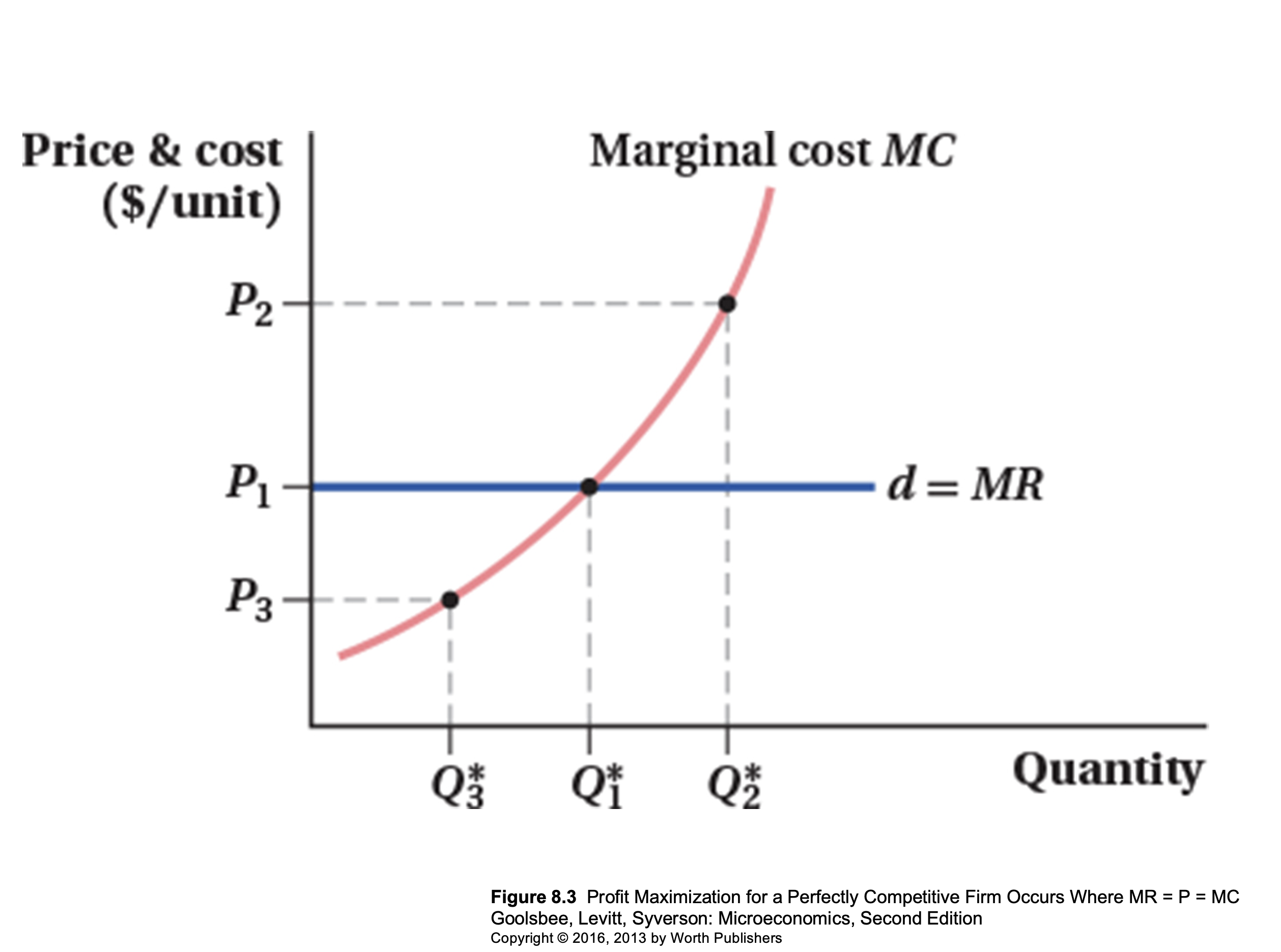
Profits are maximized when marginal revenue = marginal cost
After the point where MR=MC, your profits will be negative
Supply = MC, total cost optimized
Market Equilibrium
the intersection of the demand and supply curves
total cost is important as it is the basis of an individual firm’s supply curve
upward sloping section of the marginal cost curve is the supply curve
Efficiency of demand/supply curves
Supply curves
Optimal combination of cost-minimizing inputs for each level of output
Demand curves
Optimal combination of utility-maximizing goods for a given level of income
Market supply curve
Horizontal summation of a series of individual supply curves
Supply Theory
Supply - total amount of goods and services that producers are willing and able to purchase at a given price in a given time period
Law of Supply
as the price of a product rises, the quantity supplied of the product will usually increase (ceteris paribus)
firms attempt to maximize product by increasing quantity supplied when the price is higher (and vice versa)
Non-price determinants of supply
Changes in costs of factors of production
Prices of related goods
Indirect taxes and subsidies
Future price expectations (producer)
Changes in technology
Number of firms
Shocks
Markets only work when there is strong competition
Market Equilibrium Graphs (supply + demand)
Consumer Surplus (C.S.) - willingness to pay and what they did pay
Producer Surplus (P.S.) - difference between market price and lowest price a producer uses to produce
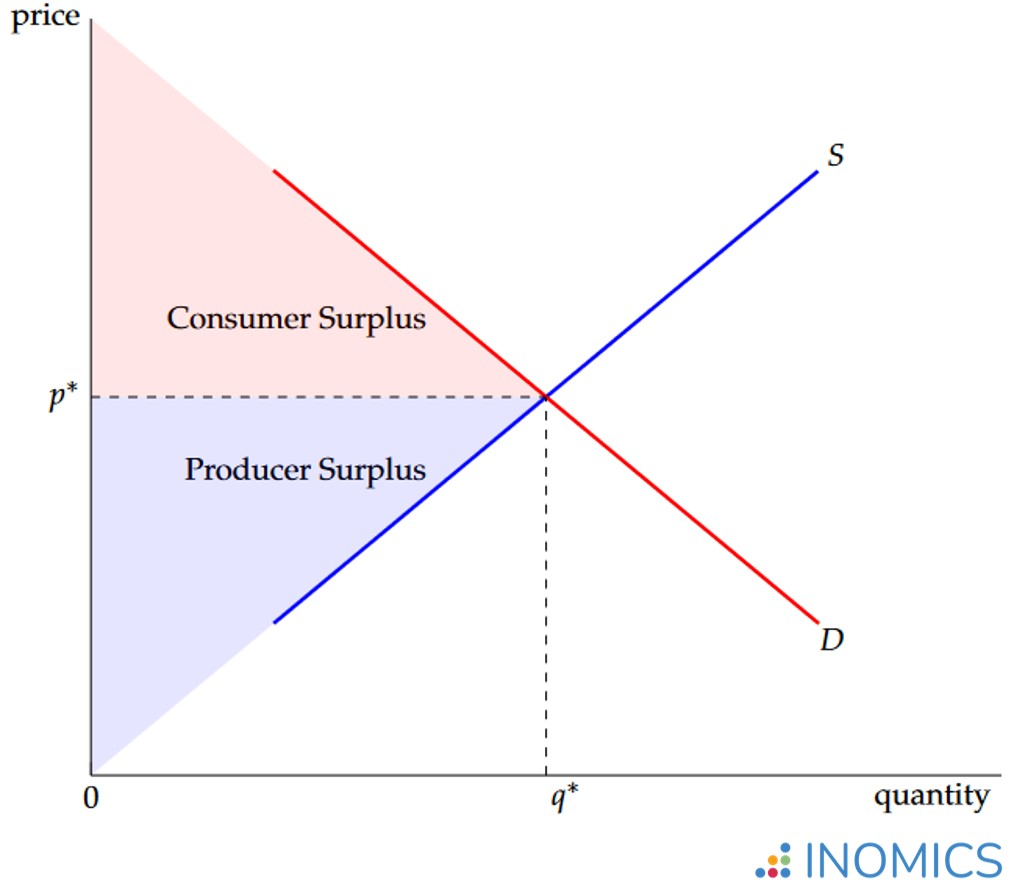 Assumptions of perfectly competitive markets
Assumptions of perfectly competitive markets
all actions (consumers/producers) have access and fully process all relevant information
there are many small buyers and producers - all with equally negligible market power
all actors are rationally self-interested
Welfare - theoretical surplus value left with different economic agents (consumers, firms, governments)
Production - market clearings
Optimal Allocation
MR = MB (marginal benefit)
Social surplus = consumer + producer surplus
In a perfectly competitive market, social surplus is at its largest
Analysis of surpluses are called “welfare analysis”
Price Mechanism Functions
A - allocation (resources are allocated to those who need it most)
R - rationing (not everyone in the market gets what they want, only those who have the same valuation of the product as the firms)
S - signaling (communication of information that drives other factors)
I - incentive (capitalist system is driven by incentives)
2 Demand Curves
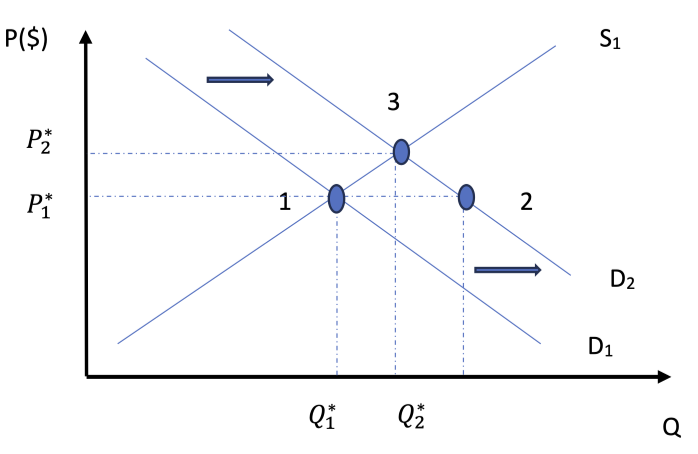
2 Supply Curves
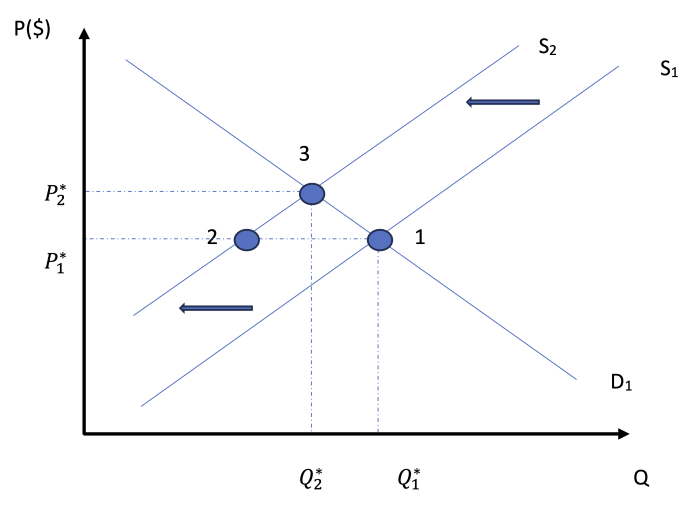
Moving from point 1 to point 3 on both graphs
Point 2 has excess supply/demand
ARSI to move to the new equilibrium point
At both equilibriums, there is optimal allocation
Structure of Microeconomics
How do consumers and producers make choices in trying to meet their economic objectives?
Demand
Supply
Competitive market equilibrium
Elasticities of Demand
Elasticities of Supply
Critique of the maximizing behavior of consumers and producers
interaction between consumers and producers determine where resources are directed
welfare is maximized if allocative efficiency is achieved
constant change produces dynamic markets
consumer and producer choices are the outcome of complex decision making
When are markets unable to satisfy important economic objectives - and does government interaction help?
Role of government in microeconomics
Market failure
externalities and common pool or common acess resources
public good
asymmetric information (imbalanced information held by consumers and/or consumers)
market power (single/small number of suppliers)
Price Elasticity of Demand (PED)
measure of the responsiveness of the quantity demanded of a good subject to the change in price
Percentage change and differentiation to calculate
PED = percentage change in quantity demanded / percentage change in price
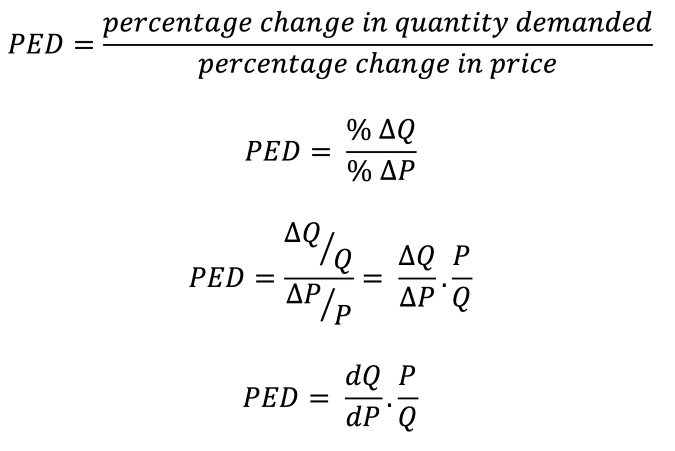
|PED| > 1 demand is relatively elastic
|PED| < 1 demand is relatively inelastic
|PED| = 0 demand is unitary
PED = ∞ perfectly elastic
PED = 0 perfectly inelastic
How can PED change along a straight line?
as you move along the x-axis, it gets less elastic
as quantity increases, elasticity decreases
How does PED change across income levels?
more elastic for lower income groups
elasticity depends on the good (price-quantity relationship)
quantity demanded changes, but not the demand curve
“staples” are essential, less elastic
Determinants of Price Elasticity of Demand (PED)
number of close substitutes; more subs = increased price sensitivity
luxuries VS staples
time - purchases made with longer time periods are generally more elastic
proportion of income spent on the good
Income Elasticity of Demand (YED)
measure of how much demand for a product changes when there is a change in the consumer’s income
YED = percentage change in quantity demanded / percentage change in income
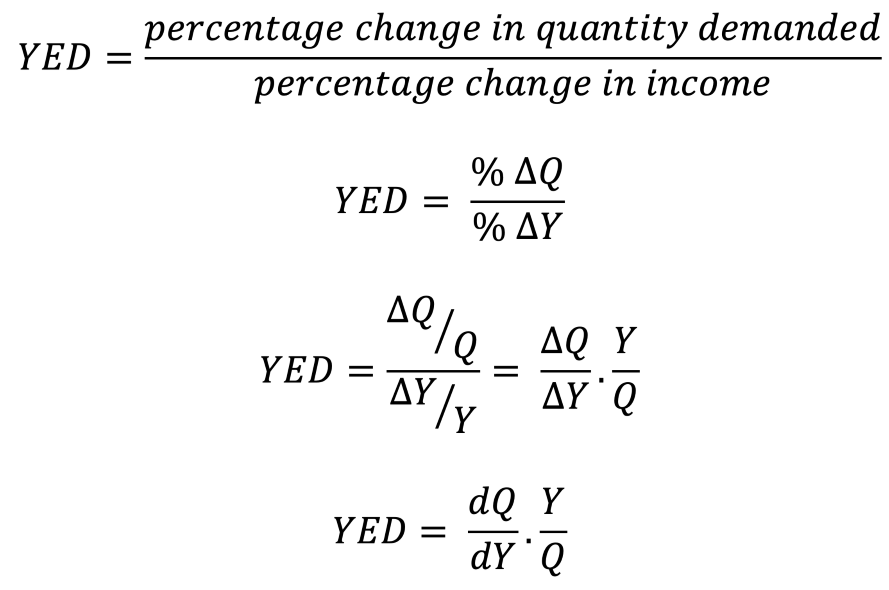
YED to categorize inferior and normal goods
Engel Curve
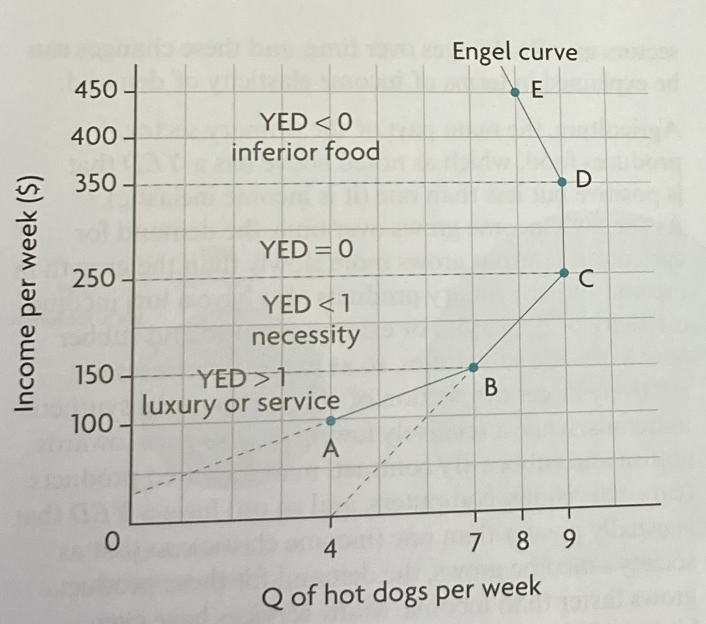
axes → income and quantity
YED > 1 luxury/service
YED < 1 necessity
YED > 0 normal good
YED < 0 inferior good
quantity demanded when income increases also increases then diminishes and goes backwards
if you continue a segment AB with the same slope and that line cuts the y-axis, then it is a luxury
if it cuts the x-axis, it is a necessity
only works on income = y and quantity = x
Primary Commodities
raw materials (cotton, coffee)
inelastic demand (they are necessities)
consumers are not everyday households, but manufacturers
Manufactured Goods
made from primary commodities
more elastic, as there are more substitutes
Why is YED important?
For firms:
products with a high YED will see a demand increase when income increases (used to see maximum profit based off changes in income)
allocation of resources to fit income groups in products
if income falls, production of inferior goods increase because of YED rules
Sectoral changes
primary sector: agriculture, fishing, extraction (forestry, mining)
secondary sector: manufacturing, takes primary products and uses them to manufacture producer goods (machinery, consumer goods) also includes construction
tertiary sector: service, produces services or intangible products (financial, education, information, technology)
shifts in the relative share of national output and employment
as countries grow and living standards improve, there is a change in proportion of the economy that is produced
extra income is spent on manufactured goods as the demand is more elastic than the primary products (using YED to measure/verify) ← same goes for the service sector
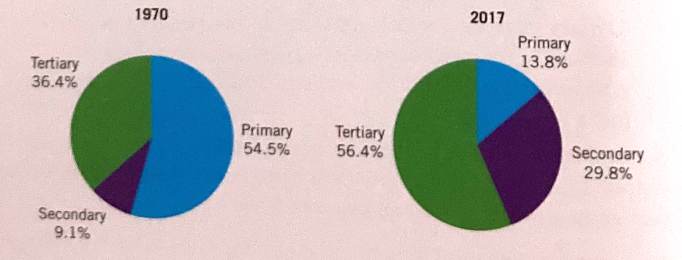
Price Elasticity of Supply (PES)
PES = percentage change in quantity supplied / percentage change in price
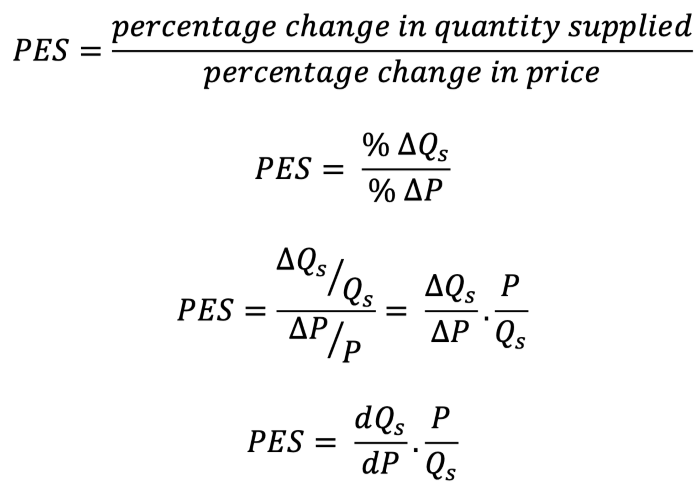 2.4 - Behavioural Economics
2.4 - Behavioural Economics
Assumptions of Rational Consumer Choice
free markets are built on the assumptions of rational decision making
in classical economic theory, rational means economics agents are able to consider the outcome of their choices and recognise the net benefits of each one
rational agents - will select the choice that reaps highest benefit/utility
Rational choice theory - individuals use logic and sensible reasons to determine the correct choice (connected to an individual’s self-interest)
Consumer Rationality
assumption that individuals use rational calculations to make choices which are within their own best interest (using all information available to them)
Utility Maximization
economic agents select choices that maximize their utility to the highest level
Perfect Information
information is easily accessible about all goods/services on the market
individuals have access to all information available at all times in order to make the best possible decision
Limitations of Assumptions of Rational Consumer Choice
behavioural economics recognizes that human decision-making is influenced by cognitive biases, emotions, social, and other psychological factors that can lead to deviations from rational behaviour
individuals are unlikely to always make rational decisions
5 limitations are shown below:
Biases
biases influence how we process information when making decisions = influence the process of rational decision making
example: common sense, intuition, emotions, personal/social norms
Types of Bias
Rule of Thumb - individuals make choices based on their default choice gained from experience (ex: same product from same company, but not the best possible choice)
Anchoring and Framing - individuals rely too heavily on an initial piece of information (anchor) when making subsequent judgements or decisions (ex: car dealer says car is worth $10,000 and you know it’s worth less, but this anchor of information causes you to purchase the car for a higher price)
Availability - individuals rely on immediate examples of information that come to mind easily when making judgements/decisions (causes individuals to overestimate the likelihood/importance of events/situations based on how readily available they are in their memory)
Bounded Rationality
people make decisions without gathering all necessary information to make a rational decision within a given time period
rational decision making is limited because of
thinking capacity
availability of information
lack of time available to gather information
too many choices also cause people to make irrational decisions
example: in a supermarket, there are too many choices of products of the same good, making it difficult to reach a decision
Bounded Self-Control
individuals have a limited capcity to regulate their behaviour and make decisions in the face of conflicting desires or impulses
self-control is not an unlimited resource
because humans are influenced by family, friends, or social settings, it causes social norms to interfere in decision making (does not result in the maximization of consumer utility)
decision making based on emotions → does not yield the best outcome
businesses capitalize on the lack of bounded self-control of individuals when appealing to their target audience to maximize sales
Bounded Selfishness
economics agents do not always act within their own self interest
individuals do things for others without a direct reward
ex: altruism - selflessness without expecting anything in return
Imperfect Information
information is not perfectly accessible due to:
intelluctual property rights
cost of accessing information
amount of information and options available
people make decisions based on limited information
asymmetric information may also lead to decisions based on limited information
when one party has more information than another
Choice Architecture
intentional design of how choices are presented so as to influence decision making
simplifies the decision making process
3 types, as shown below:
Default Choice
individual is automatically signed up to a particular choice
decision is already made even when no action has been taken
individuals rarely change from the default change
Restricted Choice
choices available to individuals are limited which helps individuals make more rational decisions
Mandated Choices
requires individuals to make a specific decision or take a particular action by imposing a requirement or obligation
mandated choices can be used to ensure compliance with regulations or societal norms, making it necessary for individuals to make certain decisions
Nudge Theory
practice of influencing choices that economic agents make, using small prompts to influence their behaviour
firms should use nudges in a responsible way to guide and influence decision making
designed to guide people toward certain decisions or actions while still allowing them to have freedom of choice
consumer nudges should be designed with transparancy, respect for individual autonomy, and clear societal benefits in mind
Profit Maximization
most firms have the rational business objectiveof profit maximization
profits benefit shareholders as they receive dividends and also increase the underlying share price
an increase in the underlying share price increases the wealth of the shareholder
profit maximization rule
when MC=MR, then no additional profit can be extracted from producing another unit of output
when MC<MR, additional profit can still be extracted by producing another unit of output
when MC>MR, the firm has gone beyond the profit maximization level of output and starts making a marginal loss on each unit produced (beyond MR=MC)
in reality, firms find it difficult to produce at the profit maximization level of output
the level may be unknown
in the short term, they may not adjust their prices if the marginal cost changes
MC changes regularly and regular price changes would be disruptive
in the long-term, firms will seek to adjust prices to the profit maximization level of output
firms may be forced to change prices by the competition regulators in their country
profit maximization level of output often results in high prices for consumers
changing prices changes the marginal revenue
Growth
increasing sales revenue/market share
maximize revenue to increase output and benefit from economies of scale
a growing firms is less likely to fail
Revenue Maximization as a Sign of Growth
in the short-term, firms may use this strategy to eliminate the competition as the price is lower than when focusing on profit maximization
firms produce up to the level of output where MR=0
when MR>0, producing another unit of output will increase total revenue
Market Share as a Sign of Growth
sales maximzation which further lowers prices and has the potential to increase market share
occurs at the level of output where AC=AR (normal profit/breakeven)
firms may use this strategy to clear stock during a sale to increase market share
firms sell remaining stock without making a loss per unit
Satisficing
pursuit of satisfactory/acceptable outcomes rather than profit maximization
decision-making approaach where businesses aim to meet a minimum threshold or standard of performance rather than striving for the absolute best outcome
small firms may satisfice around the desires of the business owner
many large firms often end up satisficing as a result of the principal agent problem
when one group (the agent) makes decisions on behalf of another group (the Principal), often placing their priorities above the Principal’s
Corporate Social Responsibility (CSR)
conducting business activity in an ethical way and balancing the interests of shareholders with those of the wider community
extra costs are involved in operating in a socially responsible way and these costs must be passed on to consumers
2.7 - Government Intervention
Why do governments intervene in markets?
Influence (increase/decrease) household consumption
provide support to firms
earn revenue
influence the level of production of firms
provide support to low-income households
correct market failure
promote equity
Microeconomic forms of government intervention
price controls
indirect taxes
subsidies
direct provision of services
command and control regulation and legislation
consumer nudges
Price controls
price ceiling + price floor
Price Ceiling
maximum price
below equilibrium point
the point where the price ceiling is set is Pmax
at Pmax, firms are willing to supply Qmax but the consumers demand a quantity above Q*
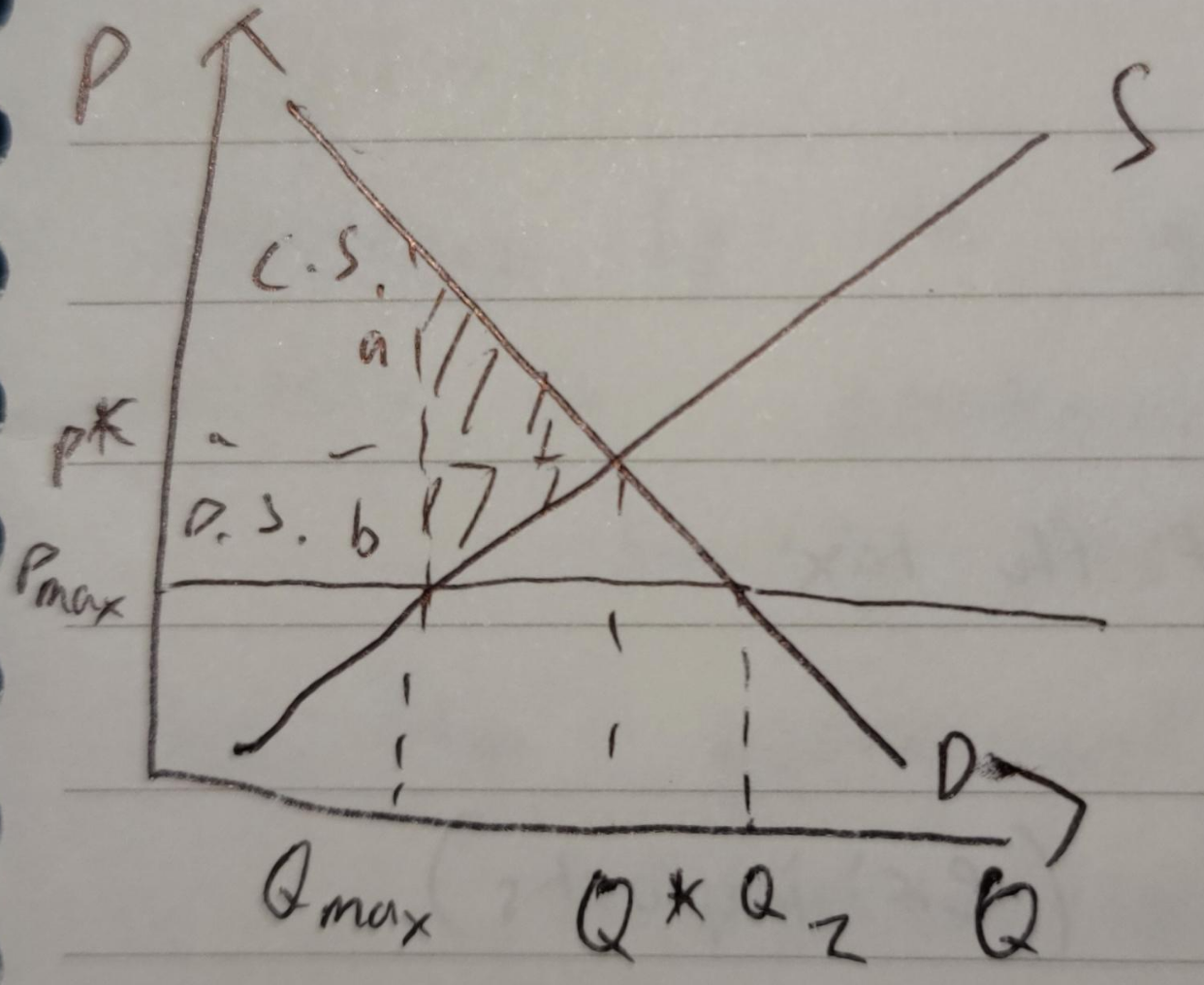
shaded area - 2 triangles, a and b
a = amount by which consumer surplus is reduced
b = amount by which produer surplus is reduced
excess demand shown by the values Qmax - Q1
managed through subsidies and tax breaks → costs
Price Floor
minimum price
above equilibrium point (Pmin)
common in agriculture
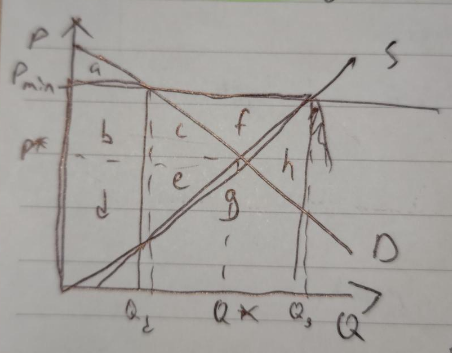
areas c, e, f, g, h are government expenditure → excess supply
producer surplus is increased (d+e → b, c, d, e, f)
f = directly from the government to the producers
a price floor creates welfare loss, indicating allocative inefficiency due to an overallocation of resources to the production of goods
society is getting too much of the good
Indirect taxes
imposed on spending to buy goods and services
both consumers and producers pay a share of the tax
firms practically pay the tax
excise taxes - imposed on particular goods/services (ex: imports)
taxes on spending - value added tax (VAT) or goods/services tax (GST)
direct taxes are those directly paid to the government by taxpayers
an indirect tax creates a tax wedge
consumers face a higher price, while producers receive a lower price
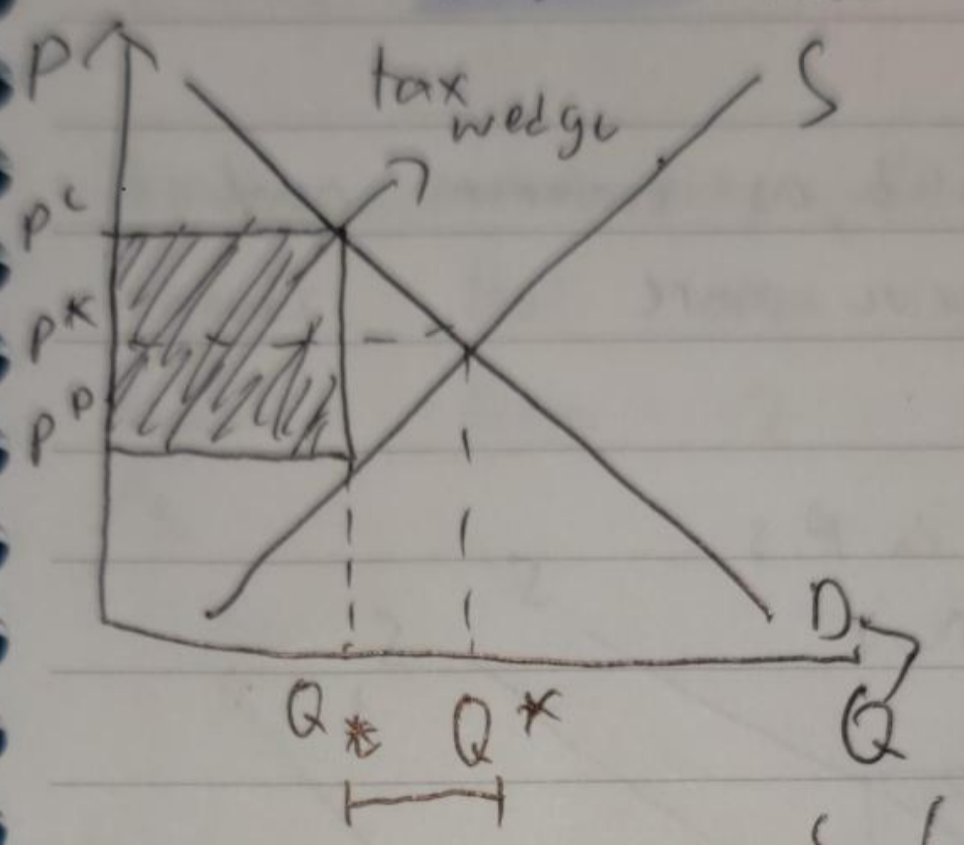
Qt - Q* → lost sales (potential sales but they are lost/didn’t happen because of the tax)
Pp - price for producers, marginal cost
area of rectangle = government revenue
Pc - price for consumers
Pc>Pp, so demand decreases
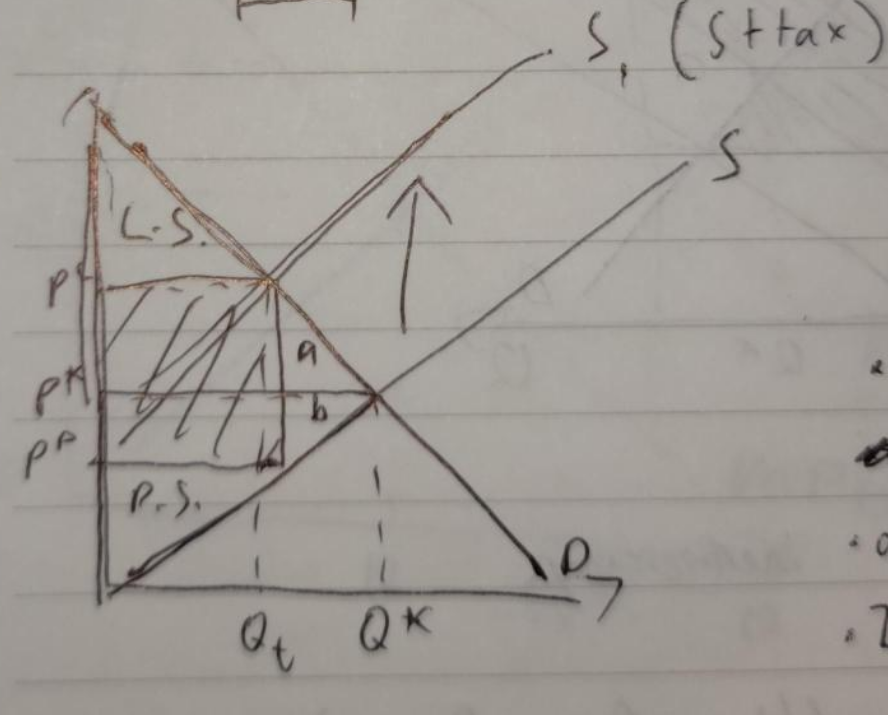
shifts from S → S1
new equilibrium point formed at (Qt, Pc)
2 triangles, a and b
a + b - welfare loss, Dead Weight Loss (DWL)
both disappear, allocative inefficiency
a - consumer surplus loss
b - producer surplus loss
2 prices, C.S. and P.S. at different equilibriums
Subsidies
assistance by the government to individuals (firms, consumers, industries)
results in greater consumer and producer surplus
society loss as government spending on subsidy
loss from government spending is greater than the gain in surplus
welfare loss (allocative inefficiency) due to overallocation of resources to the production of goods (overproduction)
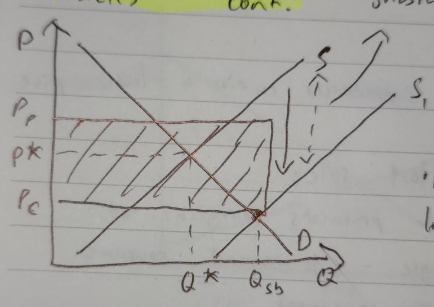
Pp and Pc switched (from indirect taxes), as consumers pay less and producers receive more
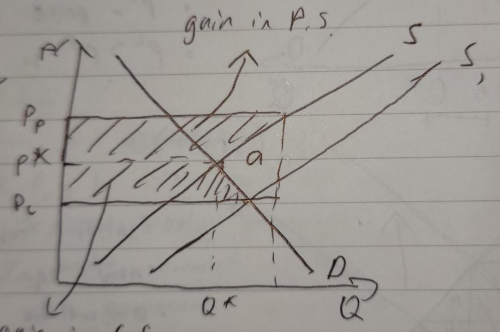
a = dead weight loss (DWL) due to overproduction
supply curve shifts (S → S1) because of one of the non-price determinants of supply (subsidies)
S1 = S + subsidy
2.8 - Market Failures
externalities are market failures, both positive and negative
Positive externality of consumption
goods that when consumed, both the consumer and third parties benefit from it (ex: healthcare)

MSC - marginal social cost
MPB - marginal private benefit
MSB - marginal social benefit
in a free market, people would consume where MPB=MSC (Q1, P1)
(Q*, P*) where MSB=MSC is the socially optimal level (potential welfare gain) because from Q1-Q*, MSB>MSC
if MPB shifts from Q1-Q* (toward MSB), then the welfare loss is gained (potential welfare gain = welfare loss)
underallocation of resources to this market (underproduction)
Merit Goods
goods that are beneficial to consumers but people do not consume enough
people underestimate/ignore potential benefits, caused by imperfect access to information
causes the demand to be lower than it should be
examples: healthcare, education
Government “fix”to positive externality of consumption
subsidies/direct provision
shifts the MSC curve downwards
new socially efficient level at Q* but at a lower price (P2)
P2 < P1 < P*
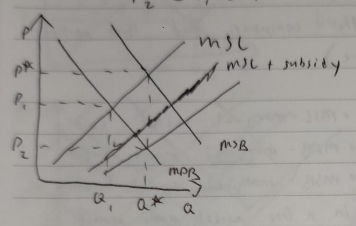
improving information (merit goods)
legislation: government passing laws that force citizens to consume the good
Positive externality of production
production of a good creates external benefits for third parties
ex: human capital: training employees
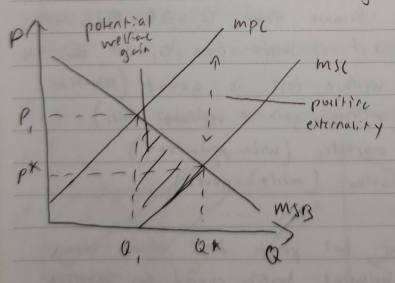
MPC - marginal private cost
produces where MPC=MSB, where Q1 is located (Q1 < Q*)
if production increases to Q*, there is a welfare gain (welfare loss turned into welfare gain)
underallocation of resources → market failure, allocative inefficiency
Government “fix” to positive externality of production
subsidies
causes MPC to be shifted downwards
full subsidy causes MPC=MSC when shifted
direct provision
high cost
offering training through the state for firms causes MPC=MSC
Negative externality of consumption
consumption causes adverse effects to third parties
ex: second hand smoking
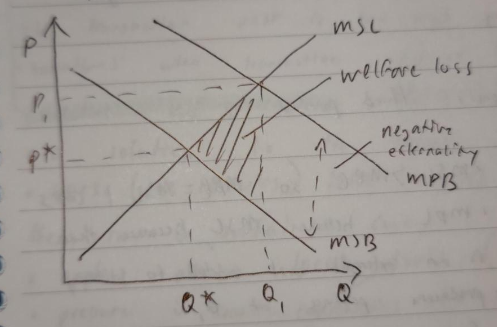 in a free market, people maximize their private utility so they consume at MPB=MSC
in a free market, people maximize their private utility so they consume at MPB=MSCthere is a welfare loss as MSC>MSB from Q*-Q1
overconsumption of goods
too many resources allocated
Demerit Goods
goods that are harmful to the consumer but people still consume either because they are unaware of or ignore the potential harm
caused by imperfect information
demand is higher than it should be
creates negative externalities when consumed
example: cigarettes
Government “fix” to negative externality of consumption
indirect taxes
taxes reduce consumption
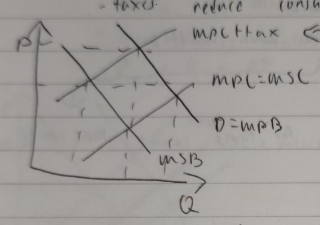
legislation/regulation
making laws against the overconsumption of demerit goods
education/raising awareness
Negative externality of production
production of a good negatively impacts third parties
example: fumes from a factory
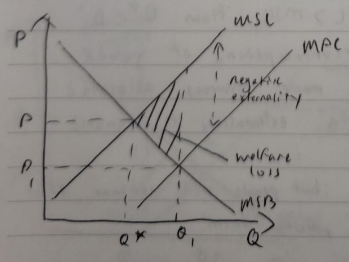
MSC<MPC so MPC=MSC+costs
MPC is below MSC, because there is an external cost added to society
producers produce at Q1
from Q1-Q*, MSC>MSB
welfare loss → market failure
Common Pool Resources
rivalrous and non-excludable (linked to negative externalities)
rivalrous: if one person uses, others cannot at the same level of utility
non-excluable: very difficult to exclude people/groups of people from using
typically natural resources
examples: fishing grounds, forests, atmosphere, etc.
Government “fix” to negative externality of production
international agreements
tradable permits
carbon taxes
legislations/regulations
subsidies
Consequences for Stakeholders
Ronald Coase → transaction costs are a way of attempting to measure the impossible, to measure the charges for externalities
externality = transaction cost; there is a threshold where the transaction cost is too high so it is considered an externality
sometimes when transaction cost is low, government intervention is not needed
Collective self-governance
a solution to the over-use of common pool resources
users take control of the resource and use them in a sustainable way
applies at a local level (small communities)
pressure in small communities to operate within social norms
Ostom’s theories → no authority needed
Carbon Tax VS Tradable Permits
carbon taxes are easier than tradable permits (design + implementation)
carbon taxes are more difficult to manipulate for/against certain groups
carbon taxes do not require as much monitoring
carbon taxes are regressive
affects low-income groups more than high-income groups
tradable permits more easily control the level of carbon reduction
carbon taxes are easier to predict
businesses need certainty to plan for the future
Common Pool Resource - rivalrous and non-excludable
Private Good - rivalrous and excludable
Public Good - non-rivalrous and non-excludable (free-rider problem)
Quasi-public Good - non-rivalrous and excludable
Asymmetric information
when one party has more information than the other
buyers and sellers do not have equal access to information
either the buyer or seller has more information
Adverse Selection
when one party in a transaction has more information on the quality of the good than the other party
Moral Hazard
one party takes risks but does not face the full costs of these risks because the full costs of the risks are borne by another party
Perfect Competition / Rational Producer Behaviour
Suppliers and consumers are made up of equally small individuals
No barriers to market entry or exit
Firms are profit maximizing
Consumers are fully rational and consistent
Products sold are homogenous
Full information throughout the market
cannot set the price:
Imperfect competition - monopolies
monopoly market - where only one supply operates
the assumption of many small suppliers does not hold
1 supplier with absolute control over the market price
monopolist sets price at maximum total revenue
as quantity increases, total cost increases, total revenue increases then decreases
Monopoly
single seller facing many buyers
profit maximization condition: ΔTR(Q)/ΔQ= ΔTC(Q)/ΔQ
MR(Q) = MC(Q)
MR>MC → firm increases Q
MC<MC → firm decreases Q
MR=MC → maximizes profit, cannot increase
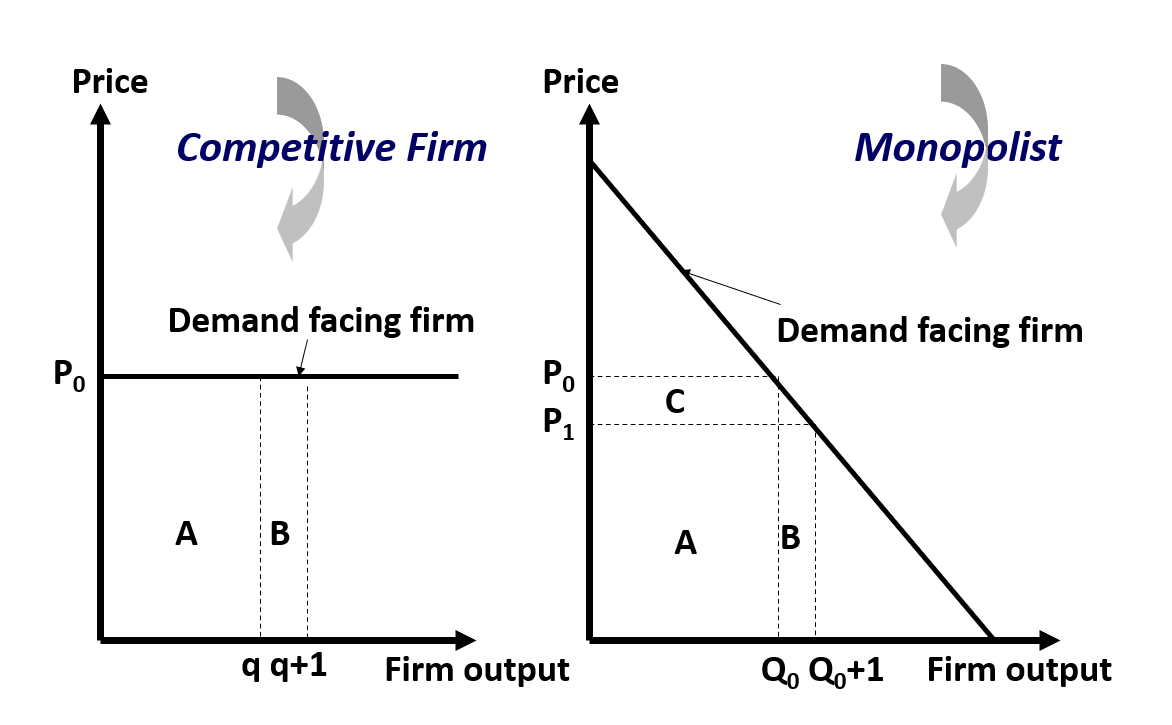
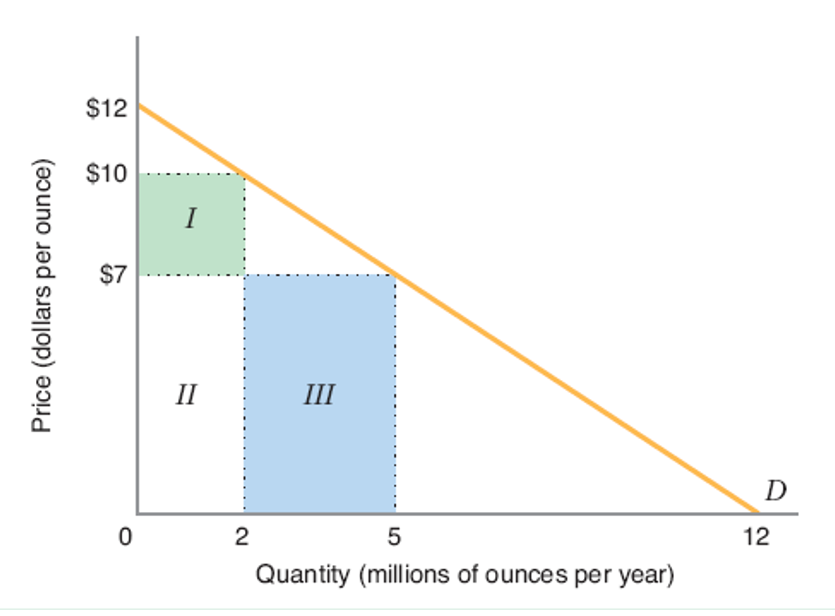
to sell more units, a monopolist lowers price
increase in profit = III while revenue sacrificed = I
change in TR = III-I
Area III = P * ΔQ
Area I = -Q * Δ
change in monopolist profit: P(ΔQ) + Q(ΔP)
MR = ΔTR/ΔQ = (PΔQ + QΔP)/ΔQ = P+Q(ΔP/ΔQ)
MR → P=increase in revenue due to higher volume - marginal units = Q(ΔP/ΔQ): decrease in revenue due to reduced price
AR = TR/Q = PQ/Q = P
price a monopolist can change to sell quantity Q is determined by the market demand curve (the AR curve = market demand curve)
AR(Q) = P(Q)
if Q>0, MR<P and MR<AC (MR lies below demand curve)
firms produce at MR=MC to maximize profits
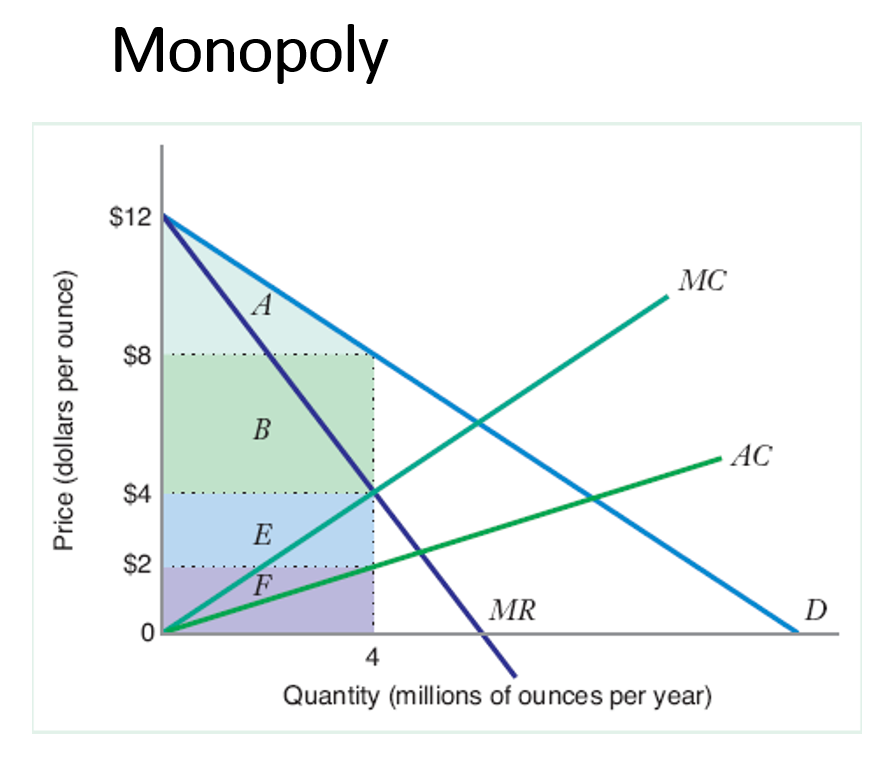
TR = B+E+F
Profit = B + E
L.S. = A
PED impacts the revenue
inelastic = more revenue
margin drives the average
P=a-bQ TR=P*Q
TR=(a-bQ)Q=aQ-bQ²
dTR/dQ = a-2bQCharacteristics of a monopoly market
single firm in the market
no close substitutes - monopolist’s good or service is unique
high barriers to entry
Long Run - factors of production are constant
Short Run - only labour can change (not land or capital)
Economies of Scale
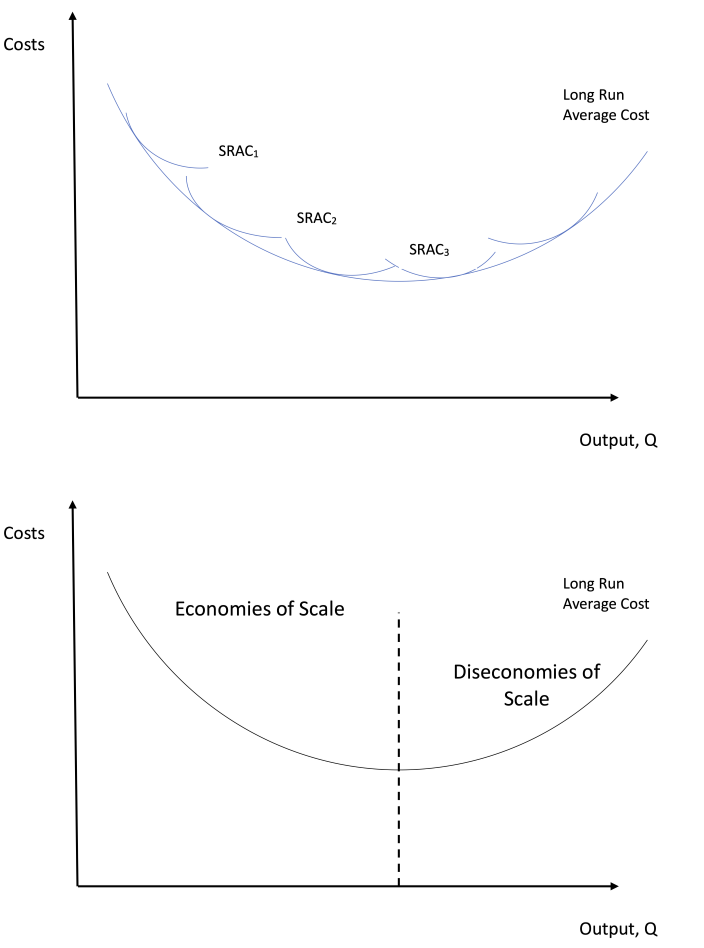
LRAC = Long Run Average Cost
considered a barrier to entry
as the monopolist increases production, their costs go down as output goes up
if new firms try to compete, they are unable to keep up with the costs of the large firm
Profits
normal (π=0) → 0 profit
entrepreneurship is factored into the costs, so the wages are added into TC
abnormal (π>0)
loss (π<0)
π = TR-TC = (PQ) - (CQ)
π/Q = AR-AC = PQ/Q - CQ/Q = P-C
AR = P, AC = Cnormal profits are defined by the minimum revenue a firm must make to keep the business from shutting down (covers implicit and explicit costs)
in a perfectly competitive market:
there are no profits in the long run
due to free entry + full information
there are economic profits in the short run
P*=AR=MR, all horizontal lines
in a monopoly market:
can change the price but are still bounded by the demand, so AR and MR are no longer horizontal lines as they are in perfectly competitive markets
Perfectly Competitive Profits
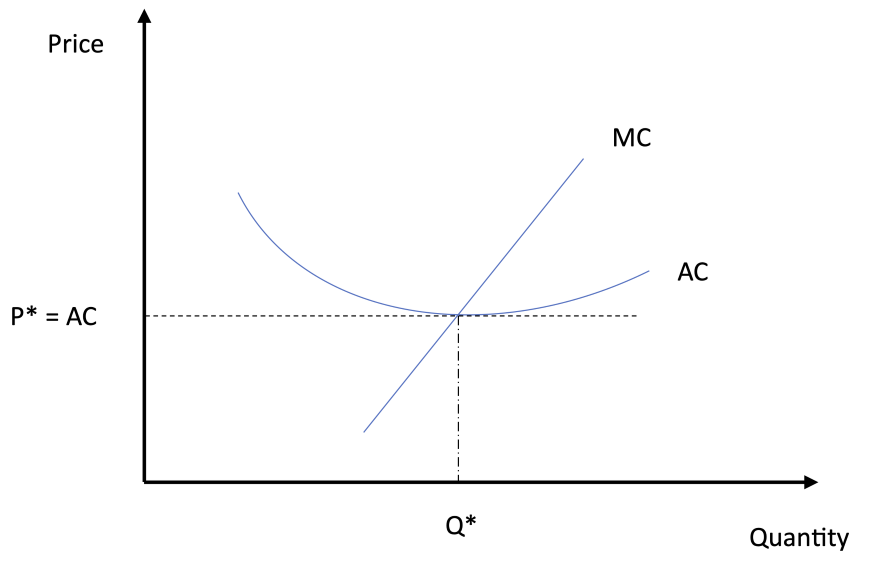
for a single firm
normal profits (P*=AC)
MC cuts AC at its minimum
P* = AR = AC (when AR=AC, π=0)
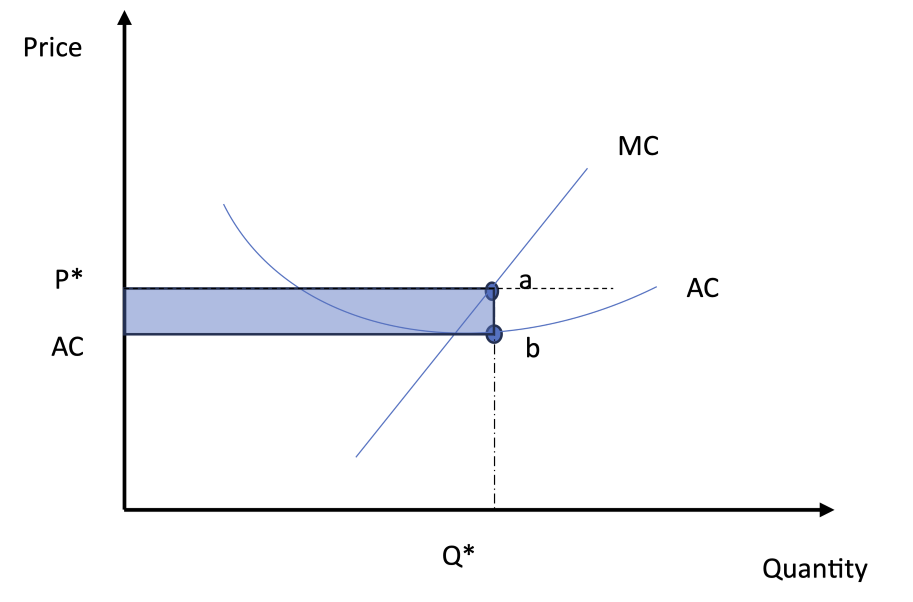
abnormal profits (P*>AC)
AR>AC, so profits are positive (π>0)
sells at Q*
shaded area = profit
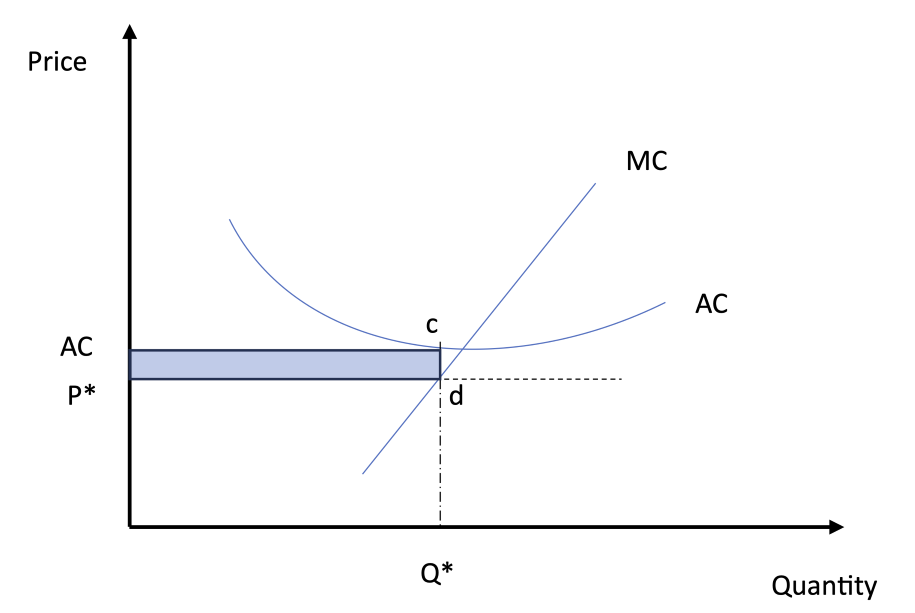
loss (P*<AC)
AR<AC, so profits are negative (π<0), so there is a loss
shaded area = loss
Rules for a single firm in a perfectly competitive market
cannot determine price, so they determine the quantity at MR=MC due to the profit maximizing rule
they also determine profit when AR=AC (AR=AC=π=0)
Monopolist Profits
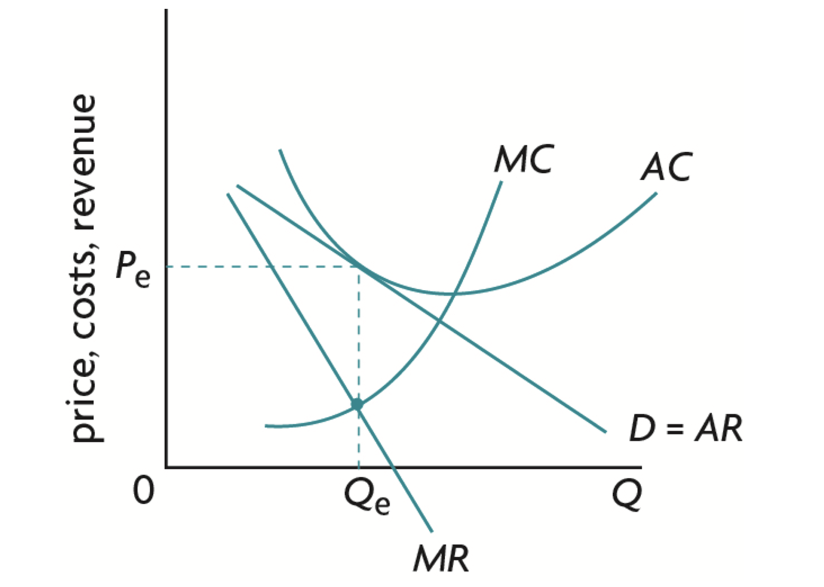
normal profit (π=0)
higher price, lower quantity
profit = difference between AR and AC
Q*=P*=AR=AC, so there is no
Am
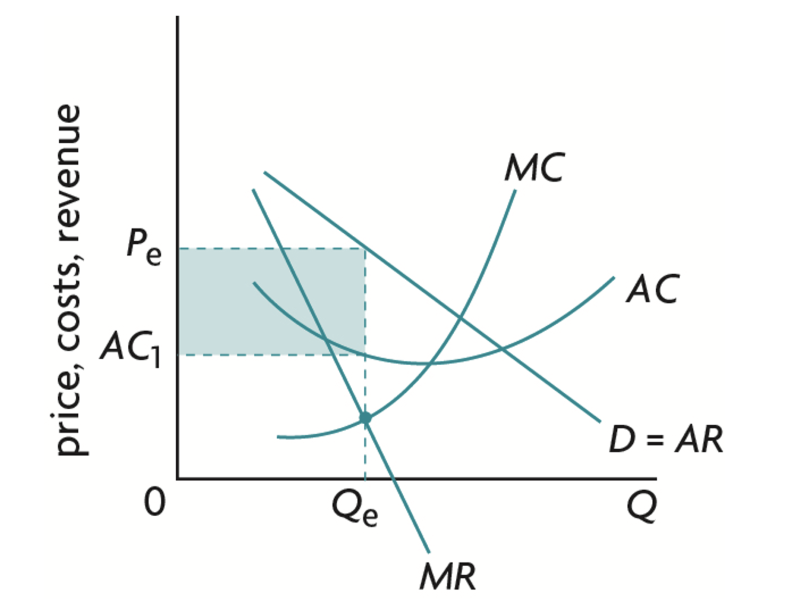
abnormal profit (π>0)
AR>AC
shaded area = profit
Q* determined where MR=MC, then find AR/D when it is equal to Q*
AC1 determined where AC is when it is at Q*
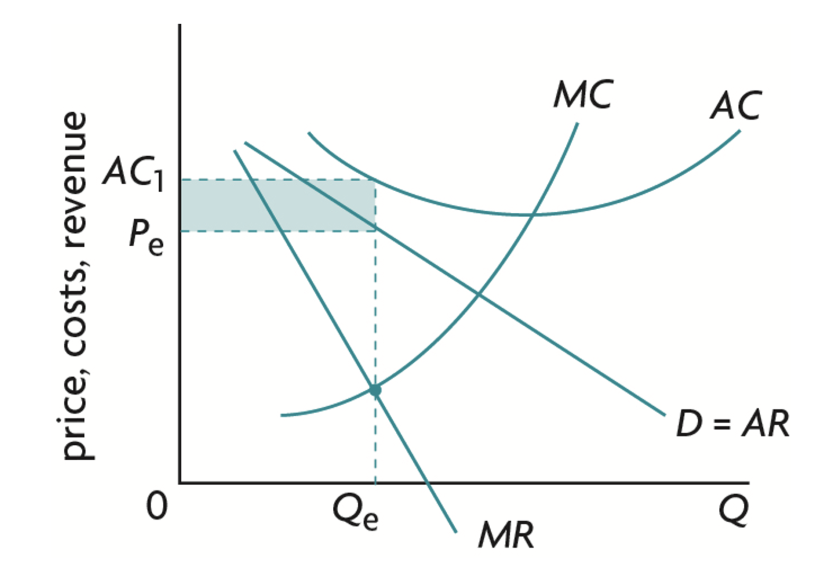
loss (π<0)
same as abnormal profit, Q*, MR=MC, but AC>AR
shaded area = negative profit = loss because cost > revenue
